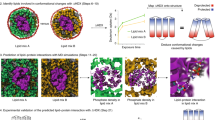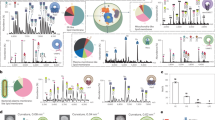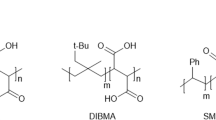Abstract
Suitable membrane mimetics are crucial to the performance of structural and functional studies of membrane proteins. Phospholipid nanodiscs (formed when a membrane scaffold protein encircles a small portion of a lipid bilayer) have native-like membrane properties. These have been used for a variety of functional studies, but structural studies by high-resolution solution-state NMR spectroscopy of membrane proteins in commonly used nanodiscs of 10-nm diameter were limited by the high molecular weight of these particles, which caused unfavorably large NMR line widths. We have recently constructed truncated versions of the membrane scaffold protein, allowing the preparation of a range of stepwise-smaller nanodiscs (6- to 8-nm diameter) to overcome this limitation. Here, we present a protocol on the assembly of phospholipid nanodiscs of various sizes for structural studies of membrane proteins with solution-state NMR spectroscopy. We describe specific isotope-labeling schemes required for working with large membrane protein systems in nanodiscs, and provide guidelines on the setup of NMR non-uniform sampling (NUS) data acquisition and high-resolution NMR spectra reconstruction. We discuss critical points and pitfalls relating to optimization of nanodiscs for NMR spectroscopy and outline a strategy for the high-resolution structure determination and positioning of isotope-labeled membrane proteins in nanodiscs using nuclear Overhauser enhancement spectroscopy (NOESY) spectroscopy, residual dipolar couplings (RDCs) and paramagnetic relaxation enhancements (PREs). Depending on the target protein of interest, nanodisc assembly and purification can be achieved within 12–24 h. Although the focus of this protocol is on protein NMR, these nanodiscs can also be used for (cryo-) electron microscopy (EM) and small-angle X-ray and neutron-scattering studies.
This is a preview of subscription content, access via your institution
Access options
Access Nature and 54 other Nature Portfolio journals
Get Nature+, our best-value online-access subscription
$29.99 / 30 days
cancel any time
Subscribe to this journal
Receive 12 print issues and online access
$259.00 per year
only $21.58 per issue
Buy this article
- Purchase on Springer Link
- Instant access to full article PDF
Prices may be subject to local taxes which are calculated during checkout







Similar content being viewed by others
References
Linke, D. Detergents: an overview. Methods Enzymol. 463, 603–617 (2009).
Lee, A.G. Lipid-protein interactions in biological membranes: a structural perspective. Biochim. Biophys. Acta 1612, 1–40 (2003).
Seddon, A.M., Curnow, P. & Booth, P.J. Membrane proteins, lipids and detergents: not just a soap opera. Biochim. Biophys. Acta 1666, 105–117 (2004).
Malia, T.J. & Wagner, G. NMR structural investigation of the mitochondrial outer membrane protein VDAC and its interaction with antiapoptotic Bcl-xL. Biochemistry 46, 514–525 (2007).
Losonczi, J.A. et al. NMR studies of the anti-apoptotic protein Bcl-xL in micelles. Biochemistry 39, 11024–11033 (2000).
Sanders, C.R. II & Landis, G.C. Reconstitution of membrane proteins into lipid-rich bilayered mixed micelles for NMR studies. Biochemistry 34, 4030–4040 (1995).
Bocharov, E.V. et al. Unique dimeric structure of BNip3 transmembrane domain suggests membrane permeabilization as a cell death trigger. J. Biol. Chem. 282, 16256–16266 (2007).
Lau, T.L., Kim, C., Ginsberg, M.H. & Ulmer, T.S. The structure of the integrin alphaIIbbeta3 transmembrane complex explains integrin transmembrane signalling. EMBO J. 28, 1351–1361 (2009).
Lind, J., Graslund, A. & Maler, L. Membrane interactions of dynorphins. Biochemistry 45, 15931–15940 (2006).
Caffrey, M. Crystallizing membrane proteins for structure determination: use of lipidic mesophases. Annu. Rev. Biophys. 38, 29–51 (2009).
Caffrey, M. & Cherezov, V. Crystallizing membrane proteins using lipidic mesophases. Nat. Protoc. 4, 706–731 (2009).
Judge, P.J. & Watts, A. Recent contributions from solid-state NMR to the understanding of membrane protein structure and function. Curr. Opin. Chem. Biol. 15, 690–695 (2011).
Denisov, I.G., Grinkova, Y.V., Lazarides, A.A. & Sligar, S.G. Directed self-assembly of monodisperse phospholipid bilayer nanodiscs with controlled size. J. Am. Chem. Soc. 126, 3477–3487 (2004).
Nath, A., Atkins, W.M. & Sligar, S.G. Applications of phospholipid bilayer nanodiscs in the study of membranes and membrane proteins. Biochemistry 46, 2059–2069 (2007).
Ritchie, T.K. et al. Chapter 11 - Reconstitution of membrane proteins in phospholipid bilayer nanodiscs. Methods Enzymol. 464, 211–231 (2009).
Fang, Y., Gursky, O. & Atkinson, D. Lipid-binding studies of human apolipoprotein A-I and its terminally truncated mutants. Biochemistry 42, 13260–13268 (2003).
Krieger, M., Brown, M.S., Faust, J.R. & Goldstein, J.L. Replacement of endogenous cholesteryl esters of low density lipoprotein with exogenous cholesteryl linoleate. Reconstitution of a biologically active lipoprotein particle. J. Biol. Chem. 253, 4093–4101 (1978).
Bayburt, T.H., Grinkova, Y.V. & Sligar, S.G. Self-assembly of discoidal phospholipid bilayer nanoparticles with membrane scaffold proteins. Nano Lett. 2, 853–856 (2002).
Etzkorn, M. et al. Cell-free expressed bacteriorhodopsin in different soluble membrane mimetics: biophysical properties and NMR accessibility. Structure 21, 394–401 (2013).
Raschle, T. et al. Structural and functional characterization of the integral membrane protein VDAC-1 in lipid bilayer nanodiscs. J. Am. Chem. Soc. 131, 17777–17779 (2009).
Yu, T.Y., Raschle, T., Hiller, S. & Wagner, G. Solution NMR spectroscopic characterization of human VDAC-2 in detergent micelles and lipid bilayer nanodiscs. Biochim. Biophys. Acta 1818, 1562–1569 (2012).
Hagn, F., Etzkorn, M., Raschle, T. & Wagner, G. Optimized phospholipid bilayer nanodiscs facilitate high-resolution structure determination of membrane proteins. J. Am. Chem. Soc. 135, 1919–1925 (2013).
Bibow, S. et al. Solution structure of discoidal high-density lipoprotein particles with a shortened apolipoprotein A-I. Nat. Struct. Mol. Biol. 24, 187–193 (2017).
Kucharska, I., Edrington, T.C., Liang, B. & Tamm, L.K. Optimizing nanodiscs and bicelles for solution NMR studies of two β-barrel membrane proteins. J. Biomol. NMR 61, 261–274 (2015).
Bibow, S. et al. Measuring membrane protein bond orientations in nanodiscs via residual dipolar couplings. Protein Sci. 23, 851–856 (2014).
Yao, Y. et al. Conformation of BCL-XL upon membrane integration. J. Mol. Biol. 427, 2262–2270 (2015).
Yao, Y. et al. Characterization of the membrane-inserted C-terminus of cytoprotective BCL-XL. Protein Expr. Purif. 122, 56–63 (2016).
Mors, K. et al. Modified lipid and protein dynamics in nanodiscs. Biochim. Biophys. Acta 1828, 1222–1229 (2013).
Kijac, A.Z., Li, Y., Sligar, S.G. & Rienstra, C.M. Magic-angle spinning solid-state NMR spectroscopy of nanodisc-embedded human CYP3A4. Biochemistry 46, 13696–13703 (2007).
Ding, Y., Fujimoto, L.M., Yao, Y. & Marassi, F.M. Solid-state NMR of the Yersinia pestis outer membrane protein Ail in lipid bilayer nanodiscs sedimented by ultracentrifugation. J. Biomol. NMR 61, 275–286 (2015).
De Zorzi, R., Mi, W., Liao, M. & Walz, T. Single-particle electron microscopy in the study of membrane protein structure. Microscopy 65, 81–96 (2016).
Gao, Y., Cao, E., Julius, D. & Cheng, Y. TRPV1 structures in nanodiscs reveal mechanisms of ligand and lipid action. Nature 534, 347–351 (2016).
Bao, H. et al. Exocytotic fusion pores are composed of both lipids and proteins. Nat. Struct. Mol. Biol. 23, 67–73 (2016).
Battiste, J.L. & Wagner, G. Utilization of site-directed spin labeling and high-resolution heteronuclear nuclear magnetic resonance for global fold determination of large proteins with limited nuclear Overhauser effect data. Biochemistry 39, 5355–5365 (2000).
Lee, D., Hilty, C., Wider, G. & Wuthrich, K. Effective rotational correlation times of proteins from NMR relaxation interference. J. Magn. Reson. 178, 72–76 (2006).
Spector, A.A. & Yorek, M.A. Membrane lipid composition and cellular function. J. Lipid Res. 26, 1015–1035 (1985).
van Meer, G., Voelker, D.R. & Feigenson, G.W. Membrane lipids: where they are and how they behave. Nat. Rev. Mol. Cell Biol. 9, 112–124 (2008).
Goricanec, D. et al. Conformational dynamics of a G-protein α subunit is tightly regulated by nucleotide binding. Proc. Natl. Acad. Sci. USA 113, E3629–E3638 (2016).
Velez-Ruiz, G.A. & Sunahara, R.K. Reconstitution of G protein-coupled receptors into a model bilayer system: reconstituted high-density lipoprotein particles. Methods Mol. Biol. 756, 167–182 (2011).
Hagn, F. & Wagner, G. Structure refinement and membrane positioning of selectively labeled OmpX in phospholipid nanodiscs. J. Biomol. NMR 61, 249–260 (2015).
Morgado, L., Zeth, K., Burmann, B.M., Maier, T. & Hiller, S. Characterization of the insertase BamA in three different membrane mimetics by solution NMR spectroscopy. J. Biomol. NMR 61, 333–345 (2015).
Susac, L., Horst, R. & Wuthrich, K. Solution-NMR characterization of outer-membrane protein A from E. coli in lipid bilayer nanodiscs and detergent micelles. Chembiochem 15, 995–1000 (2014).
Pervushin, K., Riek, R., Wider, G. & Wuthrich, K. Attenuated T2 relaxation by mutual cancellation of dipole-dipole coupling and chemical shift anisotropy indicates an avenue to NMR structures of very large biological macromolecules in solution. Proc. Natl. Acad. Sci. USA 94, 12366–12371 (1997).
Salzmann, M., Pervushin, K., Wider, G., Senn, H. & Wuthrich, K. TROSY in triple-resonance experiments: new perspectives for sequential NMR assignment of large proteins. Proc. Natl. Acad. Sci. USA 95, 13585–13590 (1998).
Goto, N.K., Gardner, K.H., Mueller, G.A., Willis, R.C. & Kay, L.E. A robust and cost-effective method for the production of Val, Leu, Ile (delta 1) methyl-protonated 15N-, 13C-, 2H-labeled proteins. J. Biomol. NMR 13, 369–374 (1999).
Mazhab-Jafari, M.T. et al. Membrane-dependent modulation of the mTOR activator Rheb: NMR observations of a GTPase tethered to a lipid-bilayer nanodisc. J. Am. Chem. Soc. 135, 3367–3370 (2013).
Hyberts, S.G., Arthanari, H. & Wagner, G. Applications of non-uniform sampling and processing. Top. Curr. Chem. 316, 125–148 (2012).
Hyberts, S.G., Robson, S.A. & Wagner, G. Exploring signal-to-noise ratio and sensitivity in non-uniformly sampled multi-dimensional NMR spectra. J. Biomol. NMR 55, 167–178 (2013).
Hyberts, S.G., Takeuchi, K. & Wagner, G. Poisson-gap sampling and forward maximum entropy reconstruction for enhancing the resolution and sensitivity of protein NMR data. J. Am. Chem. Soc. 132, 2145–2147 (2010).
Nasr, M.L. et al. Covalently circularized nanodiscs for studying membrane proteins and viral entry. Nat. Methods 14, 49–52 (2017).
Kapust, R.B. et al. Tobacco etch virus protease: mechanism of autolysis and rational design of stable mutants with wild-type catalytic proficiency. Protein Eng. 14, 993–1000 (2001).
Chen, P.S., Toribara, T.Y. & Warner, H. Microdetermination of phosphorus. Anal. Chem. 28, 1756–1758 (1956).
Fiske, C.H. & Subbarow, Y. The colorimetric determination of phosphorous. J. Biol. Chem. 66, 375–400 (1925).
Vranken, W.F. et al. The CCPN data model for NMR spectroscopy: development of a software pipeline. Proteins 59, 687–696 (2005).
Wüthrich, K. NMR of Proteins and Nucleic Acids (Wiley, 1986).
Hansen, M.R., Mueller, L. & Pardi, A. Tunable alignment of macromolecules by filamentous phage yields dipolar coupling interactions. Nat. Struct. Biol. 5, 1065–1074 (1998).
Chen, K. & Tjandra, N. The use of residual dipolar coupling in studying proteins by NMR. Top. Curr. Chem. 326, 47–67 (2012).
Bertini, I. et al. Persistent contrast enhancement by sterically stabilized paramagnetic liposomes in murine melanoma. Magn. Resonance Med. 52, 669–672 (2004).
Morgan, C.R. et al. Conformational transitions in the membrane scaffold protein of phospholipid bilayer nanodiscs. Mol. Cell Proteomics 10, M111 010876 (2011).
McDougle, D.R., Palaria, A., Magnetta, E., Meling, D.D. & Das, A. Functional studies of N-terminally modified CYP2J2 epoxygenase in model lipid bilayers. Protein Sci. 22, 964–979 (2013).
Bayburt, T.H., Leitz, A.J., Xie, G., Oprian, D.D. & Sligar, S.G. Transducin activation by nanoscale lipid bilayers containing one and two rhodopsins. J. Biol. Chem. 282, 14875–14881 (2007).
Dalal, K. & Duong, F. Reconstitution of the SecY translocon in nanodiscs. Methods Mol. Biol. 619, 145–156 (2010).
Eggensperger, S., Fisette, O., Parcej, D., Schafer, L.V. & Tampe, R. An annular lipid belt is essential for allosteric coupling and viral inhibition of the antigen translocation complex TAP (transporter associated with antigen processing). J. Biol. Chem. 289, 33098–33108 (2014).
Gawrisch, K., Soubias, O. & Mihailescu, M. Insights from biophysical studies on the role of polyunsaturated fatty acids for function of G-protein coupled membrane receptors. Prostaglandins Leukot. Essent. Fatty Acids 79, 131–134 (2008).
Ma, G. et al. Inside-out Ca(2+) signalling prompted by STIM1 conformational switch. Nat. Commun. 6, 7826 (2015).
Shenkarev, Z.O. et al. Lipid-protein nanodiscs promote in vitro folding of transmembrane domains of multi-helical and multimeric membrane proteins. Biochim. Biophys. Acta 1828, 776–784 (2013).
Bayburt, T.H. & Sligar, S.G. Membrane protein assembly into nanodiscs. FEBS Lett. 584, 1721–1727 (2010).
Silvius, J.R. Thermotropic Phase Transitions of Pure Lipids in Model Membranes and Their Modifications by Membrane Proteins (Wiley, 1982).
Orekhov, V.Y., Ibraghimov, I. & Billeter, M. Optimizing resolution in multidimensional NMR by three-way decomposition. J. Biomol. NMR 27, 165–173 (2003).
Frueh, D.P. et al. Non-uniformly sampled double-TROSY hNcaNH experiments for NMR sequential assignments of large proteins. J. Am. Chem. Soc. 128, 5757–5763 (2006).
Hyberts, S.G. et al. Ultrahigh-resolution (1)H-(13)C HSQC spectra of metabolite mixtures using nonlinear sampling and forward maximum entropy reconstruction. J. Am. Chem. Soc. 129, 5108–5116 (2007).
Mobli, M., Maciejewski, M.W., Gryk, M.R. & Hoch, J.C. Automatic maximum entropy spectral reconstruction in NMR. J. Biomol. NMR 39, 133–139 (2007).
Rovnyak, D. et al. Accelerated acquisition of high resolution triple-resonance spectra using non-uniform sampling and maximum entropy reconstruction. J. Magn. Reson. 170, 15–21 (2004).
Schmieder, P., Stern, A.S., Wagner, G. & Hoch, J.C. Improved resolution in triple-resonance spectra by nonlinear sampling in the constant-time domain. J. Biomol. NMR 4, 483–490 (1994).
Hyberts, S.G., Milbradt, A.G., Wagner, A.B., Arthanari, H. & Wagner, G. Application of iterative soft thresholding for fast reconstruction of NMR data non-uniformly sampled with multidimensional Poisson Gap scheduling. J. Biomol. NMR 52, 315–327 (2012).
Delaglio, F. et al. NMRPipe: a multidimensional spectral processing system based on UNIX pipes. J. Biomol. NMR 6, 277–293 (1995).
Gardner, K.H. & Kay, L.E. The use of 2H, 13C, 15N multidimensional NMR to study the structure and dynamics of proteins. Annu. Rev. Biophys. Biomol. Struct. 27, 357–406 (1998).
Tugarinov, V., Kanelis, V. & Kay, L.E. Isotope labeling strategies for the study of high-molecular-weight proteins by solution NMR spectroscopy. Nat. Protoc. 1, 749–754 (2006).
Plevin, M.J., Hamelin, O., Boisbouvier, J. & Gans, P. A simple biosynthetic method for stereospecific resonance assignment of prochiral methyl groups in proteins. J. Biomol. NMR 49, 61–67 (2011).
Ayala, I., Sounier, R., Use, N., Gans, P. & Boisbouvier, J. An efficient protocol for the complete incorporation of methyl-protonated alanine in perdeuterated protein. J. Biomol. NMR 43, 111–119 (2009).
Gans, P. et al. Stereospecific isotopic labeling of methyl groups for NMR spectroscopic studies of high-molecular-weight proteins. Angew. Chem. Int. Ed. Engl. 49, 1958–1962 (2010).
Acknowledgements
We thank S. Hyberts (Harvard Medical School) for advice on NMR non-uniform sampling (NUS) setup and data processing. F.H. acknowledges support of the Technical University of Munich–Institute for Advanced Study, funded by the German Excellence Initiative and the European Union Seventh Framework Programme under grant agreement no. 291763, the Helmholtz Center Munich and the Helmholtz Society (grant VH-NG-1039), the Center for Integrated Protein Science Munich (CIPSM) and German Research Foundation (DFG) grant SFB1035 (project B13). M.L.N. acknowledges support from National Institutes of Health (NIH) grant F32GM113406. G.W. acknowledges support from the NIH through grants GM075879, GM047467, GM094608, AI037581 and EB002026.
Author information
Authors and Affiliations
Contributions
F.H. performed the experiments and analyzed the data; F.H. wrote the paper, and G.W. and M.L.N. commented on and edited the paper.
Corresponding authors
Ethics declarations
Competing interests
The authors declare no competing financial interests.
Rights and permissions
About this article
Cite this article
Hagn, F., Nasr, M. & Wagner, G. Assembly of phospholipid nanodiscs of controlled size for structural studies of membrane proteins by NMR. Nat Protoc 13, 79–98 (2018). https://doi.org/10.1038/nprot.2017.094
Published:
Issue Date:
DOI: https://doi.org/10.1038/nprot.2017.094
This article is cited by
-
19F-NMR studies of the impact of different detergents and nanodiscs on the A2A adenosine receptor
Journal of Biomolecular NMR (2024)
-
Cryo-EM structure and molecular mechanism of abscisic acid transporter ABCG25
Nature Plants (2023)
-
A bivalent remipede toxin promotes calcium release via ryanodine receptor activation
Nature Communications (2023)
-
E. coli “Stablelabel” S30 lysate for optimized cell-free NMR sample preparation
Journal of Biomolecular NMR (2023)
-
Sparse pseudocontact shift NMR data obtained from a non-canonical amino acid-linked lanthanide tag improves integral membrane protein structure prediction
Journal of Biomolecular NMR (2023)
Comments
By submitting a comment you agree to abide by our Terms and Community Guidelines. If you find something abusive or that does not comply with our terms or guidelines please flag it as inappropriate.



